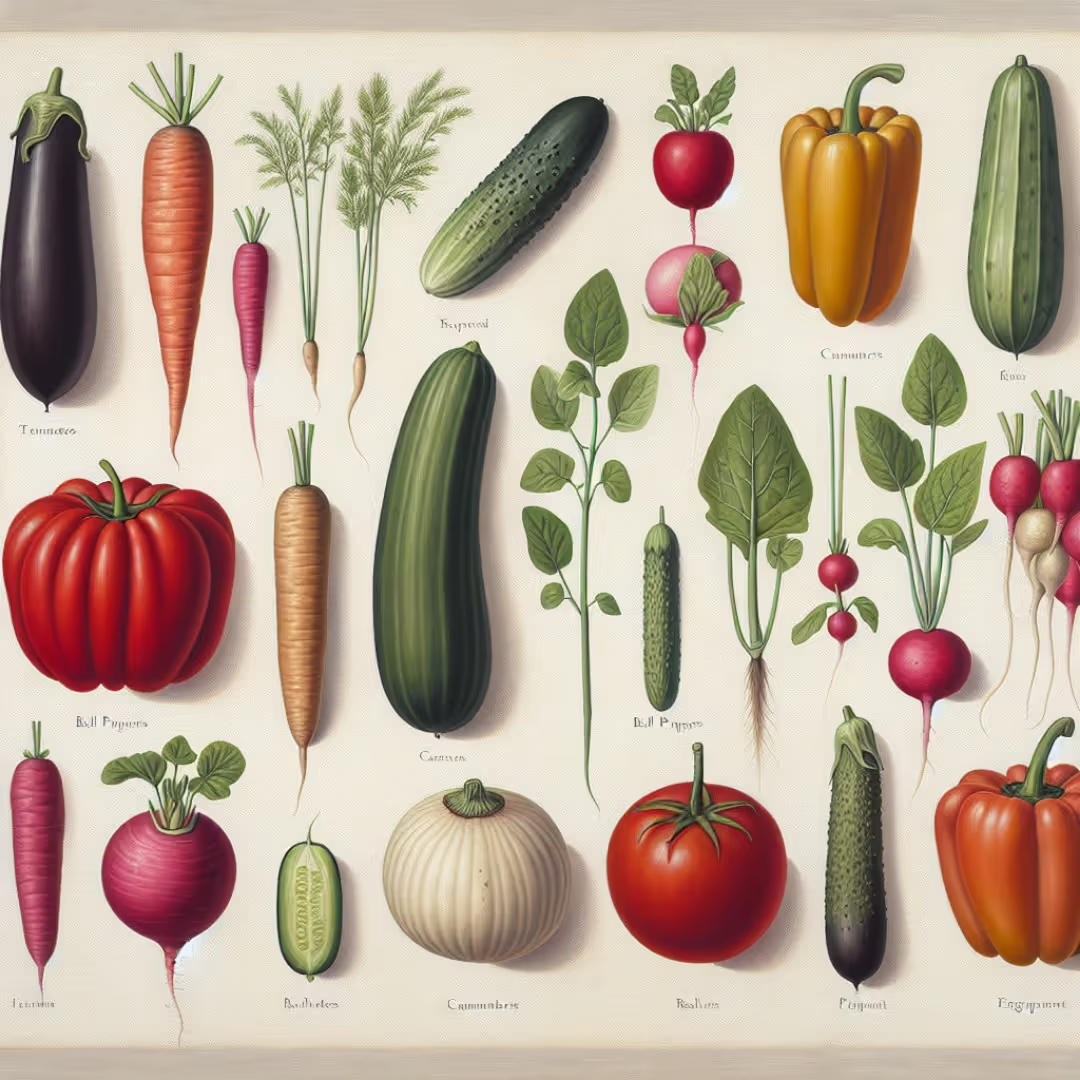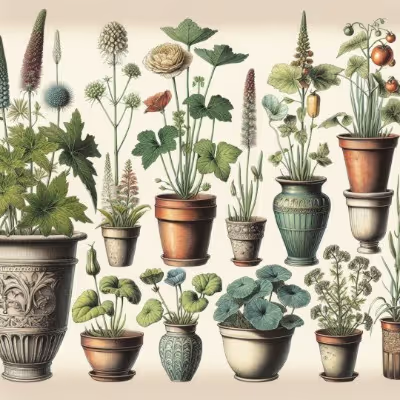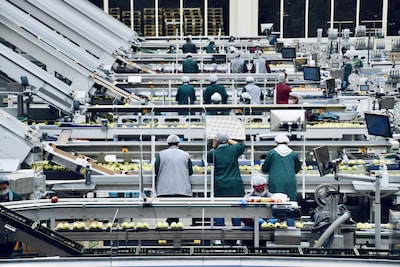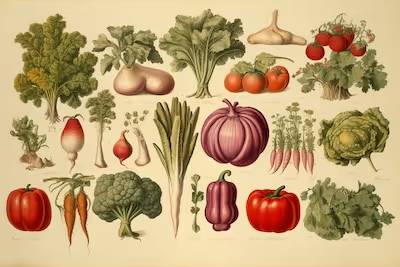Garden Vegetables List for Fresh, Flavorful Home Harvests

Garden vegetables list
Planning this year's veggie garden? A solid garden vegetables list keeps planting organized, maximizes yield and prevents rookie missteps. Our no-fluff garden vegetables list lays out the essential varieties for flavor-packed salads, hearty stews and jars of summer preserves—stick around for veggies worth your dirt and sweat.
Cheatsheet: Grow Top Veggies for Maximum Fresh Taste
🌱 Essential Vegetable Picks
- Tomatoes – 60-90 days; full sun; high vitamin C
- Salad greens (lettuce, arugula, spinach) – 30-50 days; part shade; antioxidants
- Carrots – 70-80 days; loose soil; beta carotene
- Cucumbers – 50-70 days; trellis support; hydrates
- Peppers – 60-90 days; warmth; vitamin C
- Radishes – 25-30 days; quick grower; spicy touch
- Zucchini – 45-60 days; space to sprawl; prolific
- Green beans – 50-60 days; trellis or bush
- Beets – 55-65 days; double harvest (roots and greens)
- Kale – 60-70 days; frost-tolerant; powerhouse green
🌤️ Planting Timeline & Spacing
- Last frost: sow tomatoes, peppers indoors 6-8 weeks before
- Cool soil: sow beets, carrots, kale, radishes outdoors
- Space most greens 6 in/15 cm apart; tomatoes 18-24 in/45-60 cm; cucumbers 12 in/30 cm
🧑🌾 Steps: Planning to Harvest
- Choose varieties to match local climate & flavor preference.
- Prepare soil with compost or aged manure for strong roots.
- Sow seeds or seedlings at right depth and spacing.
- Water deeply—about 1 in/2.5 cm per week, less for drought-tolerant types.
- Mulch beds to retain moisture, suppress weeds.
- Support vining crops (beans, cucumbers) with trellises or cages.
- Harvest at peak—pick daily for best flavor and yield.
🛠️ Tools and Products You'll Need
- Quality hand trowel
- Gloves
- Pruning shears
- Watering can or hose with gentle spray
- Trellises or cages for vining types
- Compost or organic fertilizer
- Mulch: straw, leaves, or bark
- Seeds or strong seedlings
🥗 Nutrition & Self-Sufficiency
Homegrown vegetables deliver up to 40% more nutrients than store-bought. Steady supply supports food security and slashes grocery bills.
I plant for flavor first, yield second, and ease of care third. This garden vegetables list mirrors that order so your beds pay you back in meals, not chores.
Pick a lane, then mix two or three lanes for a steady harvest all season.
- Beginner-proof: bush beans, cherry tomatoes, zucchini, cucumbers, leaf lettuce, radishes, chard.
- Fast food: arugula, baby kale, mizuna, radishes, baby carrots, tatsoi, scallions.
- Heat lovers: tomatoes, peppers, eggplant, melons, okra, sweet potatoes, basil.
- Cool-season anchors: peas, spinach, broccoli, cabbage, cauliflower, beets, turnips.
- Perennials: asparagus, rhubarb, sorrel, chives, Egyptian walking onions, artichoke in mild zones.
- Containers: dwarf tomatoes, bush cucumbers, compact peppers, salad bowls, herbs.
I match cultivar to microclimate and disease pressure, which saves me more time than any gadget. Here is the short list I reach for after years of trials.
- Tomatoes: Indeterminate climb and fruit until frost, determinate set one big flush. My core set: cherry "Sungold," slicer "Cherokee Purple," paste "San Marzano" or "Granadero F1" for disease resistance.
- Cucumbers: Parthenocarpic types set fruit without pollinators in tunnels. "Diva" for fresh eating, "Excelsior" for pickling, powdery mildew tolerance pays off late season.
- Lettuce: Bolt-resistant romaines like "Parris Island," heat-tolerant "Muir," and speckled butter "Flashy Trout Back" for flavor and visual pop.
- Peppers: "Shishito" for weekly yields, "King of the North" for short seasons, jalapeño "Early Jalapeno" for reliable heat units.
- Beans: Bush "Provider" for cold soil starts, pole "Fortex" for long, tender pods and vertical space savings.
- Squash: Zucchini "Dunja F1" resists powdery mildew in my humid summers. I space wide and prune leaves that touch soil.
- Broccoli: "Arcadia" or "Belstar" keep side shoots coming after the main head, which stretches the harvest window.
- Potatoes: "Yukon Gold" for early waxy spuds, late "Kennebec" for storage. Look for scab-tolerant types if soil pH runs high.
Soil temperature beats calendar dates every time. I carry a $12 soil thermometer and it has saved more seed than any trick.
- Spring at 45 to 55 F or 7 to 13 C: peas, spinach, radish, arugula, onions, potatoes. Lettuce germinates from 40 F or 4 C but pops fastest near 60 F or 16 C.
- Early summer after last frost and 60 F or 16 C soil: beans, corn, basil. I wait for 65 to 70 F or 18 to 21 C soil for tomatoes, peppers, and cucumbers to avoid sulking transplants.
- Late summer for fall: sow carrots, beets, kale, and Chinese cabbage 60 to 80 days before first frost. I use 30 to 40 percent shade cloth in heat to keep lettuce from bittering.
- Winter beds with row cover: spinach, mache, claytonia, scallions, and kale rebounds after every cold snap under light fabric.
I keep pH between 6.0 and 7.0 for most vegetables, then feed the soil life and let it feed the plants. Compost at 1 to 2 inches or 2.5 to 5 cm across beds once a year is plenty for rich loam.
USDA NRCS notes that a 1 percent increase in soil organic matter can help topsoil hold roughly 20,000 gallons of water per acre, which buffers drought and reduces irrigation swings.
I side-dress heavy feeders like tomatoes and corn with a balanced organic fertilizer at first flowers, then again three weeks later. OMRI-listed fertilizers and composted manures keep things simple and predictable.
Every harvest should trigger a replant. I cut lettuce heads, then tuck in bush beans on the same day so roots keep the soil primed.
- 7 to 14 day cycles: arugula, radish, baby lettuce, cilantro.
- 21 to 30 day cycles: bush beans, carrots, beets, scallions.
- One-and-done anchors: broccoli then side shoots, cabbage then quick mustard greens, garlic then late beans.
Good spacing and steady water beat fancy feeds. Here is my reality check from average seasons.
- Tomatoes: 10 to 15 lb or 4.5 to 6.8 kg per healthy indeterminate plant outdoors.
- Cherry tomatoes: 200 to 400 fruits per plant in drip-irrigated beds.
- Bush beans: 1 to 1.5 lb or 0.45 to 0.68 kg per plant across two pickings.
- Cucumbers: 10 to 15 fruits per plant for slicers, more in trellised tunnels.
- Leaf lettuce: 0.5 lb or 225 g per square foot or 0.09 m² in cut-and-come-again culture.
- Potatoes: 3 to 5 lb or 1.4 to 2.3 kg per seed piece, depending on spacing and hilling.
I aim for about 1 inch or 25 mm of water per week including rain, split into two deep soaks on hot weeks. Drip lines with 12 inch or 30 cm emitter spacing give me even moisture and clean foliage.
Mulch 2 to 3 inches or 5 to 7.5 cm of shredded leaves or straw to reduce evaporation and blunt soil splash that spreads disease. I stop mulch 3 inches or 7.5 cm short of stems to keep crowns dry.
I rotate families every 3 to 4 years to break pest cycles. I also plant flowers that feed beneficials right beside vegetables, not in a distant border.
- Row cover: 0.5 to 0.6 oz fabric keeps flea beetles off young brassicas and protects squash from vine borer flights.
- Scouting: flip leaves twice weekly and spot-remove eggs. I carry tape to pull squash bug egg clusters off in seconds.
- Sprays: BT for caterpillars on brassicas, horticultural soap for aphids, with label rates and calm mornings. I avoid broad-spectrum products that wipe out allies.
- Sanitation: prune tomato suckers to improve airflow and remove lower leaves that touch soil, then disinfect pruners in 70 percent alcohol between plants if blight appears.
Cornell Cooperative Extension reminds growers that early detection and resistant varieties remain the strongest tools against late blight in tomatoes and potatoes.
I run a balcony trial every year to keep myself honest about small spaces. The key is pot volume and consistent feeding.
- Tomatoes: 10 to 15 gal or 38 to 57 L fabric pots, dwarf or determinate types, one sturdy trellis.
- Peppers: 5 to 10 gal or 19 to 38 L with a light top-dress of compost midseason.
- Cucumbers: bush types in 7 gal or 26 L pots with a compact trellis, pick daily.
- Salad bowls: 10 inch or 25 cm wide bowls for cut-and-come-again mixes under 30 percent shade cloth in midsummer.
I track inputs and harvests because numbers tell the truth. A National Gardening Association report found about 70 dollars in supplies can return roughly 600 dollars of produce value in a season for a typical plot.
- Top ROI crops in my beds: salad greens, herbs, cherry tomatoes, cukes, peppers, garlic, and scallions.
- Transplants vs seed: start tomatoes and peppers at home to save. Buy starts for slow growers like celery if space or lights are limited.
CDC data has shown that fewer than 1 in 10 adults meet vegetable intake recommendations, which makes any home harvest a daily nudge toward better plates.
I prune hard choices to one or two winners per slot. These have survived heat waves, cold snaps, and my busiest weeks.
- Cherry tomato: "Sungold" for candy-sweet pop, or "Black Cherry" for complex, winey notes.
- Slicer tomato: "Cherokee Purple" for flavor, "Mountain Merit F1" for disease resistance and tidy plants.
- Paste tomato: "San Marzano" in dry summers, "Granadero F1" where disease pressure runs high.
- Cucumber: "Diva" seedless for salads, "Excelsior" for crunchy pickles.
- Sweet pepper: "Ace" in cool summers, "California Wonder" for classic bell shape.
- Hot pepper: "Early Jalapeno" for reliable heat, "Aji Amarillo" for fruity depth if your season allows.
- Leaf lettuce: "Muir" for heat tolerance, "Salad Bowl" for nonstop cuts.
- Bean: "Provider" for cold soil, "Fortex" for length and tenderness.
- Zucchini: "Dunja F1" resists powdery mildew and keeps fruit straight on trellis.
- Broccoli: "Belstar" for spring and fall, tight beads and meaty side shoots.
Overcrowding is the silent yield killer. I give tomatoes 18 to 24 inches or 45 to 60 cm, cucumbers 12 inches or 30 cm on a trellis, peppers 16 inches or 40 cm, and I prune lower leaves to improve airflow.
Determinate tomatoes get a light tidy so I do not cut yield. Indeterminates get single or double leaders on sturdy twine, which makes harvest and disease checks easy.
I cure onions and garlic at 80 to 85 F or 27 to 29 C with airflow for two weeks, then store cool and dry. Carrots and beets sit in the crisper at high humidity, unwashed, and hold for weeks.
Blanch beans for 2 to 3 minutes and freeze, or lacto-ferment cucumbers with 2 percent salt by weight for snap and probiotics. Tomato sauce reduces well with basil stems and a splash of vinegar for brightness.
I seed sweet alyssum, calendula, and dill along bed edges to feed hoverflies and lacewings that patrol aphids. I also leave a few cilantro and carrots to flower, which turns on beneficials like a neon sign.
Marigolds look great, but crop rotation and sanitation do heavier lifting against soil problems. I plant flowers for insects and rotate crops for resilience.
I plan by frost dates and use USDA hardiness zones as a rough frame, then adjust for microclimates like patios, south walls, and windbreaks. A south-facing brick wall can add a full zone of heat for peppers and eggplant.
I start lettuce and brassicas under lights 4 to 6 weeks before transplant, tomatoes and peppers 6 to 8 weeks, at 65 to 75 F or 18 to 24 C for steady growth. Seedlings get 14 to 16 hours of bright light so they stay stocky.
I lean on extension bulletins and grower trials when planning. Cornell Cooperative Extension, UC IPM, and state extension variety lists save me guesswork in tough seasons.
RHS guidance for spacing and cultural practices translates well across temperate gardens. USDA NRCS keeps me honest about soil health and water, and the National Gardening Association data grounds the ROI talk.
For seed, I split orders across a couple outfits to hedge supply: an organic-focused catalog, a trials-heavy catalog, and a heirloom specialist. I look for clearly stated disease resistances like PM, DM, LB, and CMV on product pages.
- Raised beds: 10 to 12 inches or 25 to 30 cm deep is plenty for most vegetables.
- Soil mix: 50 percent screened compost, 30 percent high-quality topsoil, 20 percent aeration like coarse perlite or pine bark fines.
- Irrigation: 1 gph or 3.8 Lph emitters on 12 inch or 30 cm spacing for most beds, with a simple timer for consistency.
- Row cover and netting: lightweight for insect pressure, 0.8 mm insect mesh for cabbage moths and beetles.
- Soil test: lab test every 2 to 3 years for pH and nutrients so fertilizer stays targeted and affordable.
I plant one extra cherry tomato to cushion pest surprises, then one fewer zucchini than I want because it will outproduce appetites. I write dates on bed tags and seed packets so I stop guessing at maturity and know exactly when to resow.
On the first 90 F or 32 C week I throw shade over lettuce and water peppers in the morning, every time. On the first cold snap I harvest tomatoes with a blush and ripen indoors at 65 F or 18 C for steady flavor.

Want smarter plant choices? 🪴
Frequently Asked Questions About Growing Vegetables in Your Garden
Which vegetables grow best in a small garden plot?
For limited garden space, choose vegetables that thrive vertically or take minimal room like pole beans, tomatoes, lettuce, spinach, and radishes. These crops produce abundant harvests even in compact areas.
How do I select vegetables that grow well together?
Use the companion planting method by grouping compatible crops. For instance, planting basil near tomatoes helps deter pests, while carrots and onions mutually benefit by repelling carrot flies and onion pests.
Can I plant vegetables that tolerate shade?
Yes, several vegetables thrive under partial shade conditions. Leafy greens such as lettuce, arugula, and kale, as well as root crops like beets and radishes, reliably perform without full sunlight.
What vegetables tolerate colder temperatures?
Choose cool-season vegetables for colder climates or early spring planting. Broccoli, cauliflower, Brussels sprouts, and Swiss chard withstand temperatures as low as 28°F (-2°C) and often yield more flavorful harvests after mild frosts.
How can I maximize vegetable growth in raised beds?
Raised beds allow intensive planting and improved soil drainage, ideal for growing vegetables. Practice square-foot gardening by dividing beds into small plots, spacing crops like peppers or carrots efficiently to maximize yield and simplify maintenance.
What are good vegetable options for beginner gardeners?
Beginner-friendly vegetables include zucchini, green beans, radishes, spinach, and lettuce. These plants germinate quickly, require minimal care, and produce dependable harvests for gardeners just starting out.
How often should I water vegetable crops?
Vegetable gardens typically require about 1 inch (2.5 cm) of water per week. Adjust watering frequency based on weather conditions, aiming for soil moisture that remains consistently damp but never waterlogged. Deep, consistent watering ensures stronger roots and healthier harvests.
Can I plant vegetables multiple times per season?
Yes, by practicing succession planting, you can sow quick-growing vegetables like spinach, radishes, or lettuce every two to three weeks. This technique provides continuous harvests throughout the growing season.
Your Garden vegetables list should match your plate and your weather. Pair quick greens with steady staples, and tuck in beans or cucumbers to climb. Sow in waves for steady bowls. Pick varieties you’ll actually cook. Keep notes, keep tasting, keep planting.
Set the table in the soil. Start with sound soil for a vegetable garden. Favor flavor and fuel with nutrient-dense vegetables. Use transplants for finicky crops and source smart at where to buy seedlings. Stay ahead of trouble with clear-eyed pest management. Keep air moving, water deep, and plan succession planting. Simple care, fresh pull, clean flavors. That is the payoff. Trim the list each season to what earned its space.
Pro Tips for Maximizing Vegetable Yields and Flavors
Intercrop Strategically
Intercropping plants like carrots between onions deters pests naturally, maximizing harvest potential without added chemicals.
Succession Plant for Continuous Harvest
Plant radishes and lettuces every two weeks in small batches for continual availability and minimal waste.
Immediate Post-Harvest Cooling
Rapidly cool harvested vegetables under shade or in cool water; flavor peaks when produce remains crisp and fresh after picking.
Optimal Soil Temperature for Germination
- Spinach: 50°F–60°F (10°C–15°C)
- Peppers: 70°F–85°F (21°C–29°C)
- Tomatoes: 70°F–80°F (21°C–27°C)
Beneficial Companion Flowers
- Calendula attracts pollinators, improving zucchini and cucumber yields up to 30%.
- Marigolds repel root nematodes, effectively protecting tomatoes and peppers without pesticides.
Soil Enrichment with Cover Crops
Plant legumes like peas or beans between vegetable rotations; they fix atmospheric nitrogen naturally, improving soil fertility by up to 20%.
Extend Season with Row Covers
Floating row covers retain warmth, safeguarding vegetables from frost damage—extending growing season by 3–4 weeks.
Harvest Times for Peak Nutrition
Leafy greens harvested early morning yield higher nutrient density than those picked midday; sugars concentrate overnight, enhancing flavor and nutritional value.
Find out which plants will thrive in your garden!
Answer a few fun questions and get custom plant recommendations perfect for your space. Let’s grow something amazing together!

start your season





